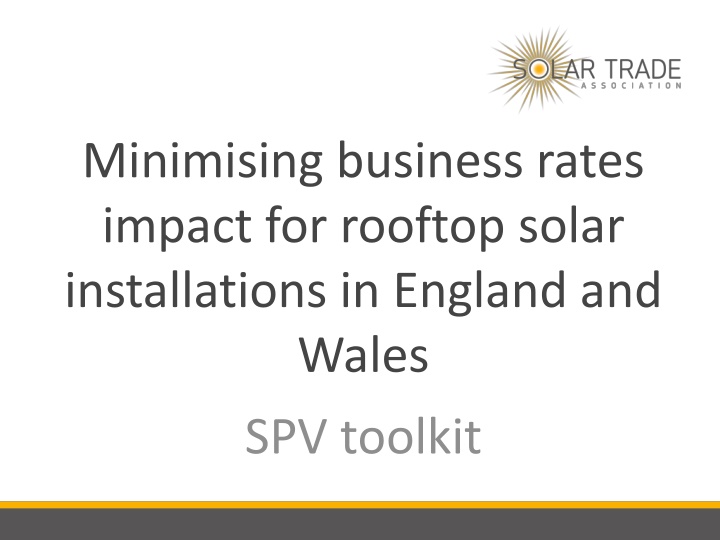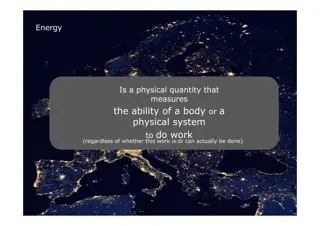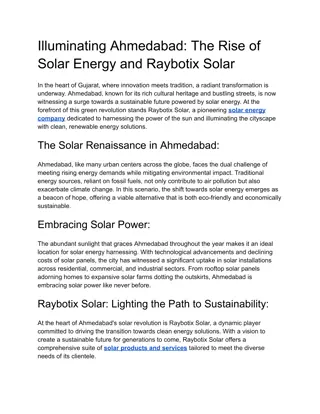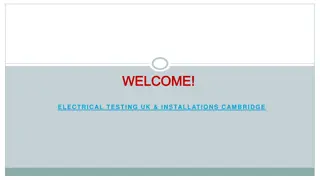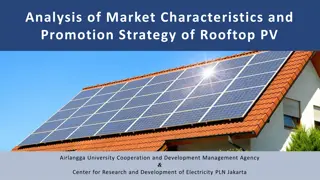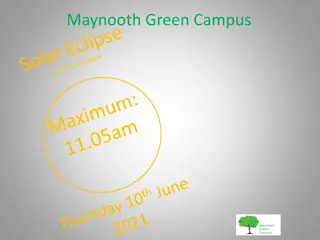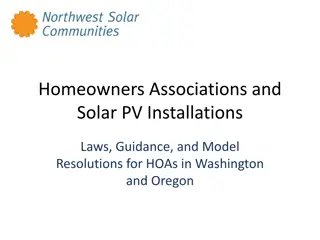Minimising Business Rates Impact for Rooftop Solar Installations in England and Wales SPV Toolkit
This document provides an overview of the issues related to business rates for commercial rooftop solar installations in England and Wales, detailing how the valuation process has changed and the potential impact on self-owned PV assets. It explains the legislative asks to address this problem and offers guidance on mitigating business rate increases through changes in legal ownership structures, with confirmation of calculations for assets primarily for self-consumption.
Download Presentation

Please find below an Image/Link to download the presentation.
The content on the website is provided AS IS for your information and personal use only. It may not be sold, licensed, or shared on other websites without obtaining consent from the author.If you encounter any issues during the download, it is possible that the publisher has removed the file from their server.
You are allowed to download the files provided on this website for personal or commercial use, subject to the condition that they are used lawfully. All files are the property of their respective owners.
The content on the website is provided AS IS for your information and personal use only. It may not be sold, licensed, or shared on other websites without obtaining consent from the author.
E N D
Presentation Transcript
Minimising business rates impact for rooftop solar installations in England and Wales SPV toolkit
Purpose of this document Objectives To explain why there is a problem with business rates for commercial rooftop solar To understand how business rates for solar are determined To acknowledge the legislative asks to resolve the problem To explain how to mitigate the business rate increase through changing the legal structure of solar panel ownership To explain how existing assets can utilise this new legal structure to mitigate the business rate increase Disclaimer: The STA does not issue legal advice. The content of this document is based on our understanding of the business rates and tax legislation and should therefore be considered as guidance only. Go to contents
Why is there a problem with business rates for rooftop solar? For self-owned PV assets where generation is consumed on-site, business rates bills will rise by a factor of almost eight if the new rules are left unchanged Previously the Valuation Office Agency (VOA) used a single method for valuing solar at a rateable value of 8/kW across all solar assets (E&W; NOT in Scotland) Following the April 2017 revaluations, solar now has two valuation types: 1. Mainly Export e.g. where assets e.g. solar farms, third-party rooftop installs, or installs set up within a special purpose vehicle (SPV), export the energy to a customer or a third party via a power purchase agreement (PPA) 2. Mainly Self Consumption e.g. supermarket, where the owner of the installation uses the electricity for self-consumption In general, mainly export valuations have fallen in line with solar installation costs and subsidy, i.e. the asset value has fallen In contrast, mainly self-consumption valuations have gone up by 6-8 times, as the method and parameters used to calculate the rateable value are fundamentally different Solar on schools, hospitals and defence premises under this method go up by 3-4 times In addition, installations smaller than 50kW which used to be exempt from business rates as microgeneration will now be subject to the rates. However in Scotland microgeneration is permanently exempt The points above are a simplified overview. The detail around business rates is complex. Go to contents
Confirmation of calculation for mainly self-consumption Hi Nick I can confirm that for 2017 Rating Lists: If the PV is primarily providing power to the hereditament rather than exporting, then it will be valued on a Contractors Basis using the following capital values - <4kw 1,400/kw installed capacity 4-150kw 1,250/kw installed capacity >150kw 1,100/kw installed capacity Rateable values are thereafter calculated simply by applying the appropriate statutory decapitalisation rate to these capital values. These rates are as follows England 4.4% (2.6% for educational, healthcare or defence) Wales 3.8% (2.1% for educational, healthcare or defence) Hope that helps. Kind Regards Bob Bob Prescott MRICS | Utilities Specialist | National Specialists Unit | Valuation Office Agency (VOA) Crown House | 60 Crown Street | Halifax | HX1 1HY | Go to contents
How are solar business rates calculated? Mainly Export would typically apply to utility-scale sites There are multiple calculation inputs including capex, subsidy level, date of installation, risk factors and hypothetical ownership split factors. However as these valuations have now been agreed with the VOA, and there is a detailed list on the STA website, we will not be covering this Note that using the mainly export valuation is the desired route for all commercial solar rooftops as the mainly self-consumption valuation for NEW installations would otherwise be as much as 1,100% higher Mainly Self Consumption This calculation is very basic and does not consider multiple inputs e.g. asset value or subsidy From April 2017, installations will be calculated based on the capital cost assumption for each of three bands of install System size Capital cost assumption ( /kW) <4kW 1,400 4-150kW 1,250 >150kW 1,100 Example: 100kW x 1,250/kW x 4.4% = 5,500 Capital cost Decapitalisation rate Rateable value Installation size The decapitalisation rate in the formula above is 2.6% for schools, hospitals and defence and 4.4% for all other installations (Note Difference for Wales) Go to contents
Calculations for OLD installations (installed prior to 1st April 2017) Decapitalisation Rates Businesses in England Schools, hospitals, defence 2.60% Wales Multipliers Standard Non-Domestic Multiplier Small Business Non-Domestic Rating Multiplier 4.40% 0.479 0.466 3.80%/2.10% Examples below are for England. Wales are very similar, Scotland - waiting for self consumption data Self Mainly Export Consumption 01 April 2017 * System Size kW 10 30 School 30 50 100 250 500 2000 Pre-2017 01 April 2017 Difference 0 0 0 0 550 1,650 975 2,750 5,500 12,100 24,200 96,800 74 222 222 346 488 1,390 2,485 9,940 743% 743% 439% 795% 1127% 871% 974% 974% 800 2,000 4,000 16,000 * See Microgeneration exemption rules in SI 2332 exemption is between the date of installation and the first five-yearly revaluation of non- domestic In other words until the next ratings list. A microgen install on the 21st March 2017, would only have 10 days of exemption. Go to contents
Calculations for NEW installations (installed from 1st April 2017) Decapitalisation Rates Businesses in England Schools, hospitals, defence 2.60% Wales Multipliers Standard Non-Domestic Multiplier Small Business Non-Domestic Rating Multiplier 4.40% 0.479 0.466 3.80%/2.10% Examples below are for England. Wales are very similar, Scotland - waiting for self consumption data Self Mainly Export Consumption 01 April 2017 * 0 then 550 0 then 1,650 0 then 975 0 then 2,750 System Size kW 10 30 School 30 50 100 250 500 2000 Pre-2017 01 April 2017 Difference 0 0 0 0 74 222 222 346 488 1,390 2,485 9,940 743% 743% 439% 795% 1127% 871% 974% 974% 800 2,000 4,000 16,000 5,500 12,100 24,200 96,800 * See Microgeneration exemption rules in SI 2332 exemption is between the date of installation and the first five-yearly revaluation of non- domestic i.e. until the next ratings list. A microgen install on the 1st April 2017, would have ~ 5 years of exemption (i.e. next rating list). Go to contents
What is the STA doing? Policy Update Mainly export installations have been agreed with the VOA and we have a Memorandum of Agreement in place with all FiT and RO installations listed by year of install. The Scottish Assessors Agency (SAA) have agreed very similar rateable value to England and Wales We have been lobbying hard to make microgeneration permanently exempt, as well as changing the legislation to ensure solar panels and cells are classed as excepted plant and machinery , which we understand would result in all solar having the same rateable whether for export or self-supply As at the beginning March 2017, we still have not had clarity on the outcome Is there a solution? Yes! By setting up solar installations under an SPV and providing a PPA to agree to export and sell the electricity to a consumer (i.e. back to the tenant) Following advice from independent business rates experts as well as the VOA, this would result in the solar installation being treated for business rates under the mainly export valuation The STA toolkit will be discussed in the following slides Go to contents
Toolkit summary The steps set out in this document are recommended to mitigate paying the higher level of business rates which take effect 1 April 2017 Why will changing the legal ownership structure help? The distinction between the two valuation methods relies on whether the power generated is mainly being consumed by the rateable occupier of the panels (essentially the company that owns/operates the panels) or whether it is mainly being exported to the grid (or supplied to a third party legal entity) The rating system treats a special purpose vehicle (SPV), i.e. a company incorporated for a specific purpose, as a rateable occupier. Therefore by incorporating an SPV and transferring your solar asset into that SPV, the SPV is deemed to be exporting power to the tenant, and is liable for the lower solar valuations In addition, an SPV would qualify for small business rates relief provided its rateable value is less than 12- 15,000 (equivalent to around 2MW of installed capacity), and therefore may pay no business rates at all. This approach has been understood following discussions with the VOA Questions If you have any questions on this document please email Gemma Stanley at the Solar Trade Association (gstanley@solar-trade.org.uk) or call (0203 637 2949) This document is purely for guidance and professional expertise should be sought on tax and legal matters Go to contents
Contents Section Page number Setting up a new SPV 11 VAT grouping 12 SPV takes ownership of PV system 13 Setting up a power purchase agreement (PPA) 14 Corporation tax 15 If you are not VAT registered 16 Summary 17 Frequently asked questions 18 The SPV process for existing PV installations 19-22 Bird and Bird PPA presentation 25-31 Go to contents
1. Setting up a new special purpose vehicle (SPV) Setting up an SPV is an essential part of the process but should be quick and low-cost. The SPV structure needs to be set up simultaneously when acquiring the new solar panels. You incorporate a new, wholly-owned company (SPV) You can incorporate the SPV yourself through Companies House (it takes 24 hours to process an application for a cost of 12) Alternatively, you can pay a formation agent to handle the process for you The process is straightforward: you must specify the new company s address (which can be the same as your existing address), its directors and shareholders BEFORE AFTER Your Your organisation organisation 100% ownership New SPV Go to contents
2. Bringing the SPV into your VAT group The new SPV should be brought into your existing VAT arrangements. If you do not VAT register the SPV then VAT at 5% will be chargeable on electricity sales from the SPV, and VAT on any costs associated with the panels (e.g. maintenance) will not be recoverable. If you have an existing VAT group If you already have a VAT group, the SPV must be added, via VAT forms VAT50 and VAT51. These forms can be filled out online or by post. If you have an existing single VAT registration If you currently have a single VAT registration, you should create a new VAT group If you are not VAT registered See separate slide if you are not VAT registered AFTER BEFORE Existing VAT group/single registration Your Your New VAT group organisation organisation 100% ownership 100% ownership New SPV New SPV Go to contents
3. SPV takes ownership of solar panels Regardless of which of your corporate entities pays for the solar panels, the new SPV must be the legal owner of them BEFORE AFTER The SPV must be the legal owner of the new solar panel system This has no bearing on where the panels are physically installed; it is purely a question of legal ownership The new SPV will then sell electricity to your organisation via a power purchase agreement (see next slide) Your Your organisation organisation 100% ownership 100% ownership New SPV PV system New SPV Go to contents
3. Setting up a power purchase agreement (PPA) Your new SPV exports (sells) the generated electricity at a commercial rate BEFORE AFTER It is essential to demonstrate that the SPV exports (sells) electricity to a different legal entity Given that you will own the SPV, it is purely a question of internal accounting; you will not need to transfer cash back and forth The price per kWh of electricity will need to be commercial i.e. it cannot be free Your Your organisation organisation 100% ownership Supply of electricity Notional payment New SPV 100% ownership PV system New SPV PV system Go to contents
4. Corporation tax The corporation tax impact of the SPV structure should be zero provided the correct filings are made An online corporate tax return will need to be prepared for the SPV Because the SPV is selling electricity, it will generate taxable income (even if no cash is transferred) However because your organisation will have a corresponding loss from paying for the electricity from the PV system, the net tax effect should be zero. This can be dealt with via group relief on your tax return The SPV will also be able to deduct capital allowances on the PV system from its taxable profit Your organisation Supply of electricity Notional payment 100% ownership New SPV PV system Go to contents
If you are not VAT registered If you are not already VAT registered, supplies from the SPV may take you over the VAT registration threshold (currently 83,000 over a 12 month period). Supplies for these purposes means the electricity sold by the SPV. Electricity sales from the SPV will count towards the VAT registration threshold, even though they stay within your group If you remain under the VAT registration threshold, you are not obliged to register but may wish to do so anyway in order to recover VAT on costs associated with the solar panels (e.g. maintenance costs) Go to contents
Summary 1 SET UP NEW SPV 2 BRING SPV INTO VAT GROUP 3 SET UP POWER PURCHASE AGREEMENT (PPA) 4 CORPORATION TAX FILINGS 5 APPLY FOR SMALL BUSINESS RATE RELIEF Go to contents
Frequently asked questions Question Answer Is setting up an SPV with a PPA seen as tax avoidance? We have spoken with the VOA and other Government departments and they are aware that having a different legal ownership structure with solar is very common e.g. the landlord/tenant relationship; setting up third party funding; provision of PPA s etc. How do the VOA know whether I have solar panels? Through the recent valuation process, businesses will have been asked to declare if they have solar installed. Owners of solar installed prior to April 2017 will be liable for business rates from 1st April going forward (we are getting this confirmed by the VOA) How do I know what method is being used to rate my solar? Sometimes the rateable value will be listed on your business rate statement under plant and machinery ,but in many cases you will need to undertake a check, challenge appeal by writing to the VOA Why should I check what I m being charged Unfortunately the VOA and the local councils will not know the legal structure of your solar installation unless they are notified don t assume! Considering an installation could attract a rateable value of ~1200% difference between the two valuation outcomes, we advise clarification Do I need to notify the VOA of my SPV and PPA arrangement? You should notify the VOA of the arrangement so that the rateable value of your property is correctly valued using the mainly export method. You can check these values against the table on our website. Does this structure work for existing systems? Yes you can convert your existing solar installation into an SPV and a PPA then follow the check, challenge appeal process to notify the VOA of the change in structure. See our separate document on existing installations What is the >50% rule? For self-owned, self consumption solar, if you have a metered system and can prove that >50% of your generated solar is exported then your system should be valued using the mainly exported method Go to contents
1. EXISTING INSTALLATIONS - Setting up a new special purpose vehicle (SPV) Setting up an SPV is an essential part of the process but should be quick and low-cost. The SPV structure needs to be set up simultaneously when acquiring the new solar panels. You incorporate a new, wholly-owned company (SPV) You can incorporate the SPV yourself through Companies House (it takes 24 hours to process an application for a cost of 12) Alternatively, you can pay a formation agent to handle the process for you The process is straightforward: you must specify the new company s address (which can be the same as your existing address), its directors and shareholders BEFORE AFTER Your Your organisation organisation PV system PV system 100% ownership New SPV Go to contents
2. Bringing the SPV into your VAT group The new SPV should be brought into your existing VAT arrangements. If you do not VAT register the SPV then VAT at 5% will be chargeable on electricity sales from the SPV, and VAT on any costs associated with the panels (e.g. maintenance) will not be recoverable. If you have an existing VAT group If you already have a VAT group, the SPV must be added, via VAT forms VAT50 and VAT51. These forms can be filled out online or by post. If you have an existing single VAT registration If you currently have a single VAT registration, you should create a new VAT group If you are not VAT registered See separate slide if you are not VAT registered Once the new VAT group is set up, ownership of the PV system should be transferred to the SPV AFTER BEFORE Existing VAT group/single registration Your Your New VAT group organisation organisation PV system 100% ownership 100% ownership New SPV New SPV PV system Go to contents
3. Setting up a power purchase agreement (PPA) Your new SPV exports (sells) the generated electricity at a commercial rate BEFORE AFTER It is essential to demonstrate that the SPV exports (sells) electricity to a different legal entity Given that you will own the SPV, it is purely a question of internal accounting; you will not need to transfer cash back and forth The price per kWh of electricity will need to be commercial i.e. it cannot be free Your Your organisation organisation 100% ownership Supply of electricity Notional payment New SPV 100% ownership PV system New SPV PV system Go to contents
4. Corporation tax The corporation tax impact of the SPV structure should be zero provided the correct filings are made An online corporate tax return will need to be prepared for the SPV Because the SPV is selling electricity, it will generate taxable income (even if no cash is transferred) However because your organisation will have a corresponding loss from paying for the electricity from the PV system, the net tax effect should be zero. This can be dealt with via group relief on your tax return The SPV will also be able to deduct capital allowances on the PV system from its taxable profit Your organisation Supply of electricity Notional payment 100% ownership New SPV PV system Go to contents
